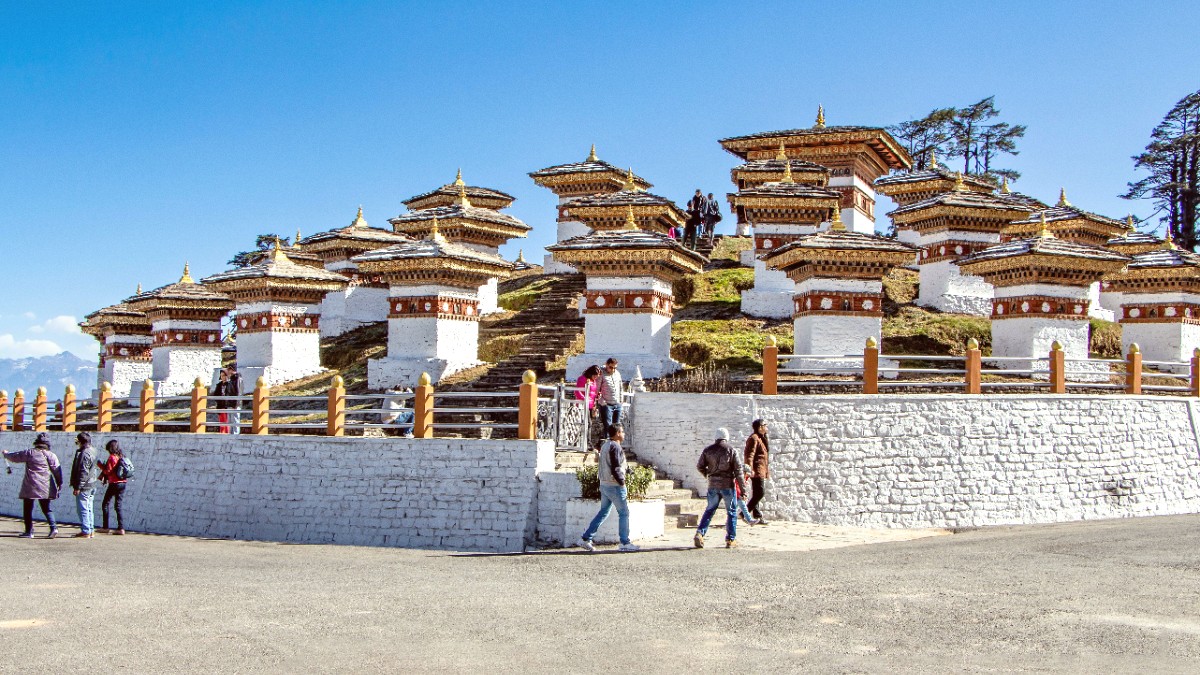
Bhutan
These sites are central to Thimphu's identity, offering both historical depth and spiritual insight. Plan visits to capture the best light and atmosphere.
A local guide will greatly enhance your understanding of their cultural context and history.
This site is a popular photo spot and a spiritual hub for locals.
Large, white stupa built in memory of the third Druk Gyalpo. A focal point for daily worship for locals who circumambulate clockwise.
Ancient temple from the 12th century overlooking Thimphu valley. Popular for newborn naming ceremonies and blessings.
Both are open daily. Memorial Chorten has a small entrance fee. No fee for Changangkha Lhakhang.
At Memorial Chorten, observe local devotion and walk clockwise. Changangkha offers panoramic views and local spiritual practices.
Thimphu’s museums offer valuable insights into Bhutan’s rich heritage, arts, and traditions, providing a understanding of the country's unique cultural fabric.
Living museum showing traditional Bhutanese rural life with recreated farmhouse, tools, and exhibits. Open Tuesday-Sunday, small fee. Highlights: authentic tools, traditional cooking demonstrations.
Celebrates the art of weaving. Displays historical and contemporary textiles, including royal garments. Open Tuesday-Sunday, small fee. Highlights: live weaving demonstrations, authentic woven products for purchase.
"School of 13 Arts and Crafts." Preserves and promotes traditional arts like painting, sculpting, wood carving. Open weekdays, small fee. Highlights: observe students practicing various arts, purchase finished products.
Preserves and promotes Sowa Rigpa (traditional Bhutanese medicine). Houses a clinic, library, and museum. Open weekdays, small fee. Highlights: learn about traditional medicine principles, purchase herbal medicines.
One of the oldest dzongs in Bhutan, built in 1629 by Zhabdrung Ngawang Namgyal. Now a monastic school for Dzongkha. About 15-20 min drive south of Thimphu.
Located on the former site of Tashichho Dzong, this monastic school houses around 450 young monks and holds historical artifacts including 12th-century Thangka paintings.
Constructed in the early 16th century, one of Bhutan’s oldest monasteries. Functions as a monastic astrology school for traditional Bhutanese astrology and spiritual healing.
Thimphu and its immediate surroundings are home to several sites steeped in history, offering glimpses into Bhutan's past.
These sites offer architectural beauty, historical depth, and peaceful environments for reflection.
While Thimphu is an urban center, it is surrounded by nature, offering opportunities for scenic escapes and appreciation of Bhutan’s biodiversity, from botanical gardens to mountain passes.
About an hour's drive from Thimphu towards Punakha. Features Bhutan’s diverse flora, especially rhododendrons which bloom spectacularly in spring. Trails and a serene lake.
Mountain pass (3,100m / 10,200ft) between Thimphu and Punakha. Famous for 108 memorial chortens. Clear days bring breathtaking panoramic views of the eastern Himalayas. Visit early for best views.
A few hours' drive from Thimphu, an U-shaped glacial valley and important wildlife preserve. Winter home (mid-Oct to mid-Mar) for endangered Black-necked Cranes. Serene beauty, Gangtey Monastery, nature walks.
Located in Thimphu, this preserve houses the Takin, Bhutan's national animal, an unique mammal resembling a goat-antelope. Easily accessible.
Book Takin Preserve tickets via GetYourGuideThimphu valley and its surrounding forests are home to a variety of birdlife. Birdwatching excursions are arranged with your guide.
Explore nature tours on GetYourGuideVisit Phobjikha Valley during winter (mid-October to mid-March) to observe these endangered cranes in their winter habitat.
Find wildlife tours on GetYourGuideIn specific higher-altitude regions, you might find Himalayan Monal, Musk Deer, or Bharal (Blue Sheep).
Discover nature experiencesYour tour operator can coordinate visits to these natural attractions as part of your itinerary.
Beyond the well-known sites, Thimphu holds several less-visited places that offer unique insights and experiences for a cultural connection.
These opportunities bring you closer to authentic Bhutanese life and breathtaking natural beauty.
The Centenary Farmers Market (open Friday to Sunday) is a significant attraction on the riverbank.
Farmers sell fresh produce, dairy, and handicrafts. A true glimpse into local life and culture.
Plan your visit to Tashichho Dzong carefully, noting its limited opening hours for tourists.
Access for tourists is generally available only after government offices close on weekdays (typically after 5 PM) and during the day on weekends and public holidays.
While the Dzong is a must-see, Thimphu has many other attractions that can be visited with more flexible schedules.
For attraction tickets and tours, use platforms like GetYourGuide to explore available options in and around Thimphu.
Always confirm booking details with your tour operator as well.
Discover unique aspects of Bhutanese culture and nature by visiting Thimphu's less-explored sites.
These sites offer a cultural immersion and scenic beauty.
Gain insights into Bhutan's rich heritage through its dedicated museums and institutes.
These institutions play a role in preserving Bhutanese culture.
Most popular attractions like Buddha Dordenma and Memorial Chorten are easily accessible by car from the city center.
Some, like Changangkha Lhakhang, are on hilltops requiring a short drive or walk, offering scenic views.
Natural attractions and historical sites further afield, like Dochula Pass, involve a scenic drive from Thimphu.